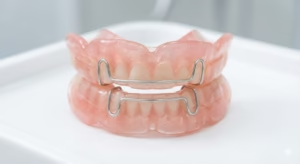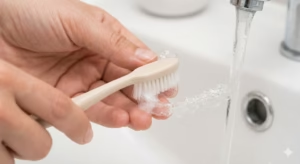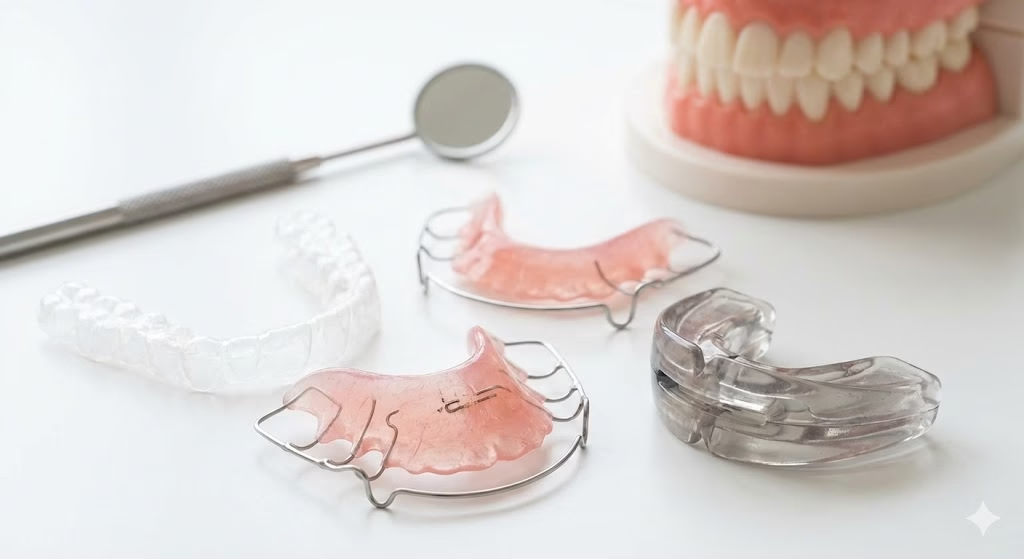Introduction: Beyond the Brackets
For decades, the mental image of orthodontics was synonymous with one thing: fixed metal braces. The “train tracks” aesthetic, while clinically effective, often came with a stigma of discomfort, dietary restrictions, and a visible appearance that deterred many adults and self-conscious teens from seeking treatment.
But the field of dentistry has evolved. Today, achieving a perfectly straight, healthy smile is more accessible, discreet, and convenient than ever before, thanks to rapid advancements in removable orthodontic treatment.
If the thought of permanent wires and brackets has kept you from pursuing a smile transformation, you are in luck. Removable orthodontics offers a powerful solution for patients of all ages, blending clinical efficacy with lifestyle flexibility. This comprehensive guide explores every facet of these modern marvels—from revolutionary clear aligner treatment to essential bite-correcting appliances and the classic Hawley retainer—equipping you with the knowledge to confidently discuss your best options with a dental professional.
I. What is Removable Orthodontic Treatment?
At its core, removable orthodontic treatment refers to any dental appliance used to correct tooth alignment or jaw discrepancies that can be taken out of the mouth by the patient. Unlike fixed braces, which are bonded to the enamel and connected by archwires for the duration of treatment, removable appliances put the power—and the responsibility—in the patient’s hands.
A. The Core Difference: Fixed vs. Removable
The primary distinction lies in patient compliance.
- Fixed Braces: The treatment is “always on.” The forces work 24/7, regardless of the patient’s daily routine.
- Removable Appliances: These are designed to be worn for a specific number of hours per day (typically 20–22 hours for active movement). They are removed for eating, brushing, and flossing. This makes them a popular choice for those who value hygiene and aesthetics, but success relies entirely on the commitment to wearing them.
B. The Mechanics of Movement
How can a removable device move bone and teeth? It works through the biological principle of pressure and release.
- Force Application: The appliance is custom-fabricated to push slightly against specific teeth or jaw structures.
- Bone Remodeling: This sustained pressure stimulates osteoclasts (cells that break down bone) on the pressure side and osteoblasts (cells that build bone) on the tension side.
- Movement: As the bone remodels, the tooth drifts into the new space. Removable appliances like clear aligners do this in small, incremental steps, whereas functional appliances may guide the growth of the jaw itself.
II. The Stars of Removable Orthodontics: Clear Aligners
The most significant innovation in modern orthodontics is undoubtedly clear aligner treatment. Often referred to as “invisible braces,” these devices have democratized orthodontics for professionals and adults who require a discreet appearance.

A. How Clear Aligner Treatment Works
The process is a marvel of digital dentistry, moving away from manual wire-bending into the realm of 3D printing and CAD/CAM technology.
- Digital Scanning: Instead of uncomfortable physical impressions, an orthodontist uses an intraoral scanner to create a precise 3D digital model of the patient’s dentition.
- Virtual Treatment Planning: Specialized software maps out the movement of every single tooth from its current position to the final desired goal. Patients can often view a “digital preview” of their future smile before starting.
- The Aligner Series: A series of clear, BPA-free plastic trays is manufactured. The patient wears set #1 for a week or two, then switches to set #2, and so on. Each tray is slightly different, guiding teeth step-by-step.
B. Benefits: Why Choose Aligners?
- Invisible Teeth Straightening: They are incredibly discreet. Most people will not notice they are being worn unless viewed from a very close distance.
- Unrestricted Diet: Because they are removed to eat, there are no “banned foods.” Patients can enjoy popcorn, apples, corn on the cob, and sticky treats without fear of breaking a bracket.
- Superior Hygiene: Brushing and flossing around fixed wires is difficult and often leads to plaque buildup. With aligners, the trays are simply removed, allowing for normal oral hygiene routines.
III. Removable Appliances for Bite Correction (Functional Appliances)
While aligners focus on moving teeth, another category of removable orthodontics focuses on the jaws. These are primarily used in children and teens (Phase 1 treatment) to correct skeletal issues. These are known as removable functional appliances.
A. Correcting the “Bad Bite”
Functional appliances are designed to fix malocclusions, such as overbites (Class II) or underbites (Class III), by harnessing a child’s natural growth potential.

- Twin Blocks: This common appliance consists of upper and lower acrylic blocks that interlock at a specific angle. When the patient bites down, the blocks force the lower jaw forward. Over time, this stimulates the lower jaw to grow into a balanced position with the upper jaw.
- Benefits in Early Growth: Using these appliances during a child’s active growth spurt (typically ages 10–14) can sometimes prevent the need for jaw surgery or extraction of permanent teeth later in life.
B. Palatal Expanders
While many palatal expanders are fixed, removable options exist for milder cases. They are used to widen a narrow upper jaw (palate) to resolve crossbites and create room for crowded teeth. A screw in the center of the appliance is turned periodically to gently push the two halves of the upper jaw apart.
IV. The Crucial Role of Removable Retainers
Once active treatment is complete—whether via braces or aligners—the most critical phase begins: Retention.
A. The Golden Rule: Retention is Forever
Teeth have a “memory.” The elastic fibers in the gums that hold the teeth in place have a natural tendency to pull them back to their original, crooked positions. This phenomenon is called relapse. To prevent this, a retainer must be worn indefinitely, usually nightly.
B. Types of Removable Retainers
- The Hawley Retainer:
It is the classic retainer consisting of an acrylic plate that sits on the roof of the mouth (or floor of the mouth) and a metal wire that wraps around the front teeth.

Pros: Extremely durable, adjustable (the wire can be tightened by a professional), and allows upper and lower teeth to “settle” naturally into a comfortable bite.
Cons: The metal wire is visible across the front teeth, and the acrylic bulk can temporarily affect speech.
2. Clear (Essix) Retainers:
Design: These look almost identical to clear aligner trays but are made of a slightly thicker, more durable plastic.
Pros: Virtually invisible and very comfortable. They hold the teeth in their exact position.
Cons: They cover the biting surfaces of the teeth (which can wear down over time) and cannot be repaired if they crack—they must be replaced entirely.
Also Read: The Different Types of Retainers After Braces
V. Cost, Comfort, and Care: A Practical Comparison
When considering removable orthodontic treatment, patients often weigh three main factors: cost, comfort, and maintenance.
A. The Cost of Removable Braces vs. Fixed
The cost of removable braces (specifically clear aligners) has become very competitive with traditional options.
- Average Cost: Generally ranges from $3,000 to $8,000, depending on the complexity of the case and geographic location.
- Factors: Comprehensive cases requiring 18+ months of aligners will cost more than “express” cases for minor spacing issues.
- Insurance: Many dental insurance plans now cover clear aligners to the same extent as traditional braces (usually up to a lifetime maximum).
B. Comfort and Speech
- Pain Levels: Removable appliances are generally considered more comfortable than metal braces because there are no sharp wires to poke the cheeks. However, when switching to a new aligner tray, patients often feel “tightness” or soreness for 24–48 hours. This is a positive sign that the teeth are moving.
- Speech Adaptation: Any appliance that occupies space in the mouth (especially Hawley retainers or Twin Blocks) can cause a temporary lisp. The tongue usually adapts within 3 to 5 days of consistent wear.
C. Hygiene: Preventing Bacterial Buildup
Since these devices are worn for 20+ hours a day, keeping them clean is vital to prevent odors and cavities.

- Rinse Immediately: Whenever the appliance is removed, it should be rinsed with lukewarm water.
- Avoid Hot Water: Heat can warp the plastic, ruining the custom fit.
- Daily Cleaning: Brush the appliance gently with a soft toothbrush and clear liquid soap. Avoid abrasive toothpaste, which creates micro-scratches where bacteria can hide.
- Soak: Use a retainer or denture cleaning tablet once a week to kill bacteria and keep the appliance clear.
Pro Tip: Always place the removable appliance in its protective case when not in the mouth. Wrapping it in a napkin during meals is the leading cause of accidental loss!
VI. Is Removable Orthodontic Treatment Right for You?
While the allure of invisible teeth straightening is strong, removable treatment is not a one-size-fits-all solution. Candidacy depends on a careful evaluation of dental conditions and lifestyle habits.
A. Ideal Candidates
- Mild to Moderate Malocclusion: Effective for crowding, gaps, and standard overbites/underbites.
- Responsible Patients: Those who can commit to the strict 22-hour wear rule.
- Periodontally Healthy Patients: Healthy gums are a prerequisite for moving teeth safely.
B. Limitations
Severe skeletal discrepancies, impacted teeth (teeth stuck in the bone), or teeth that need to be rotated significantly (turned around) may still require the heavy force mechanics of fixed metal or ceramic braces. An honest consultation with an orthodontist is the only way to determine the correct tool for the job.
Also Read: Lingual Braces: Cost, Benefits, and Complete Guide
VII. Conclusion: A Modern Approach to a Healthy Smile
The landscape of orthodontics has changed forever. Removable orthodontic treatment has shifted the narrative from “enduring braces” to “living with aligners.” It offers a path to a beautiful smile that fits seamlessly into a busy, modern lifestyle, offering hygiene benefits and aesthetic freedom that traditional methods simply cannot match.
Whether the goal is correcting a childhood relapse with a new Hawley retainer, straightening a smile for a special event with clear aligner treatment, or guiding jaw development with removable functional appliances, the technology exists to achieve results comfortably.
However, the most sophisticated tool is only as good as the hands that guide it. Success requires a partnership between a skilled orthodontic provider and a compliant patient.
Take the Next Step
If you are considering improving your smile, the best first step is information. Schedule a consultation with a qualified orthodontist in your area. They can provide a comprehensive 3D scan, discuss your specific needs, and determine if removable orthodontics is the right path for your dental health journey.

